past exhibitions
'mmmmm'
DIAGRAM / naif and mymaybe idiot summary of something we knew.
Lucie Renneboog
27. February 2009– 11. April 2009
Private View: 27. February 2009, 7 - 9 pm
 Lucie Renneboog: installation view
Lucie Renneboog: installation view
With this site-responsive solo show, the Belgian artist Lucie Renneboog is presenting her workfor the first time in Germany .
Renneboog's interventions out of everyday materials can be read as both, drawings and sculptures, they function as casual notations of her artistic as well as spatial concept and at the same time are defining a material space within the gallery space. They disassemble art into its basic parts – into lines, light, pigments, paper and frames. Light is construed out of primary colours, the line on the wall is at the same time an object and a picture of a structural rift, drawing paper is wrapped into a large ball or torn in its frame and enters into a fragile spatial compound with the other objects, and is nevertheless is a constant reminder of its own artistic tradition.
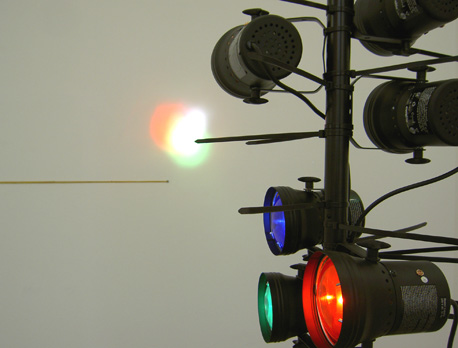 Lucie Renneboog: R.G.B., 2009
Lucie Renneboog: R.G.B., 2009
The works by Lucie Renneboog are not thinkable without looking at art history's established styles and perspectives, even though they also constantly are plumbing their depths – especially since they desist the traditional form and use the materials in a very playful way.
 Lucie Renneboog: Vertical Slash \ / Slash Horizontal Transportation,
2009
Lucie Renneboog: Vertical Slash \ / Slash Horizontal Transportation,
2009
Lucie Renneboog was born in Dendermonde in 1976, she studied at HISK, Antwerp and today lives and works in Ghent and Dendermonde.
What we do when we think about love
Roland Iselin
21. November 2008 – 30. January 2009
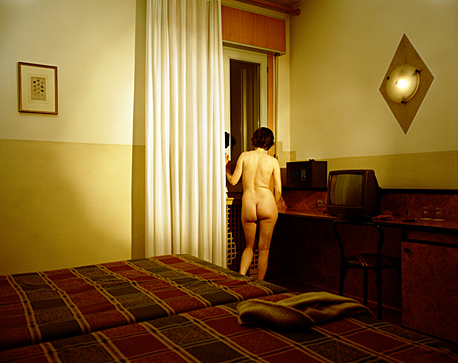 Roland Iselin: What we do when we think about love, 2007, 88 x 110
cm
Roland Iselin: What we do when we think about love, 2007, 88 x 110
cm
During the last years, Zurich photographer Roland Iselin (*1958 in Kreuzlingen/CH) has departed from documentary photography and chose a more obviously narrative approach for his works.
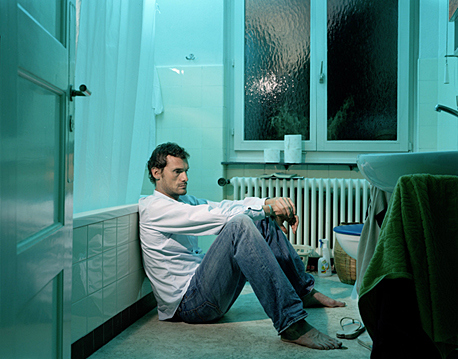 Roland Iselin: Waiting (Peter), 2006, 88 x 110 cm
Roland Iselin: Waiting (Peter), 2006, 88 x 110 cm
From the photographs in this exhibition no complete narrative can be deduced. Like the beginning of a short story, these photographs describe situations, they seems to refer to a mood or a dramatic action, but are never illustrative. For an interpretation of the scenes the viewers have to rely on their own visual vocabulary, they have to see them through their own experiences – and thus their own stories become part of Iselin's pictures.

Roland Iselin: What we do when we think about love, 2007, 88 x 110
cm
After 'a season of film' that we successfully showed last Spring, and that focussed on the relation between documentary material and dramatic stories, this show is again looking at artistic strategies of information transfer.
Pro Helvetia – , the and the .
The exhibition is supported by Pro Helvetia – Swiss Arts Council, the Cultural Foundation of the Canton Thurgau and the Swiss Federal Office of Culture, BAK.
sammlung witkowski
Nick Crowe
26. September 2008 - 08. November 2008
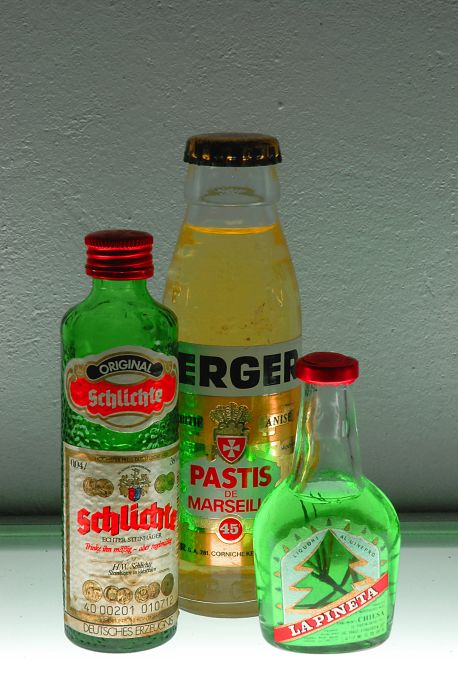
Wojciech Jan Witkowski was born in Warsaw in April 1930 and died in London in February 1997. A trained engineer he worked mainly on gas installations in the UK, Sweden and Italy, using his frequent travels to amass a sizeable collection of alcoholic miniatures. This collection was recently acquired by Nick Crowe and forms the basis of his forthcoming exhibition at Axel Lapp Projects.
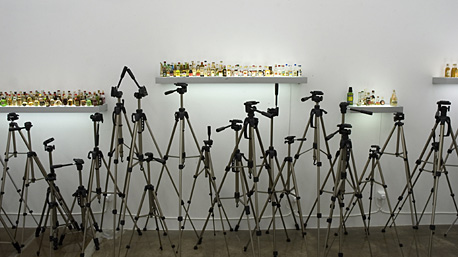
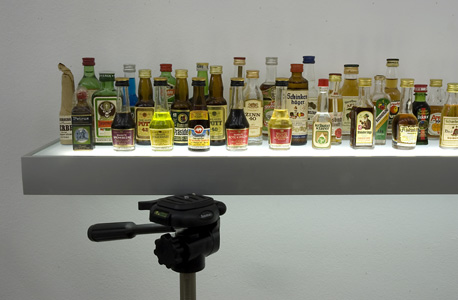
Nick Crowe: Sammlung Witkowski, installation view
Like any collection this one reflects the interests and concerns of the collector. Wojciech Witkowksi was a man whose life history was, like many men and women of his generation, intimately connected to the broader geopolitical struggles that defined twentieth century Europe. For Crowe the act of collecting can be read as a means of comprehending, and to some extent, resisting this history. These small glass vials, containing garish liquids of sometimes dubious quality, are totems of this resistance. Unconsumed, with unbroken seals and intact caps, these objects represent a means of replacing the historical processes that lead to flight and displacement with the far slower spectacle of evaporation. Sammlung Witkowski (The Witkowski Collection) acts as a memorial to one man?s lifetime struggle with history.
/ OUT OF TIME /
Cane CapoVolto, Kristina Frei, Frederico Lupo, Pietro Mancini, Robert Morgan, Egle
Oddo, Ima Picó, Nacho Ruiz, Stephana Schmidt, Filippos Tsitsopoulos and Sergio
Zavattieri.
The exhibition is organised by La Sala Naranja, Valencia, and
curated by Sergio Zavattieri.
20. june 2008 - 26. july 2008
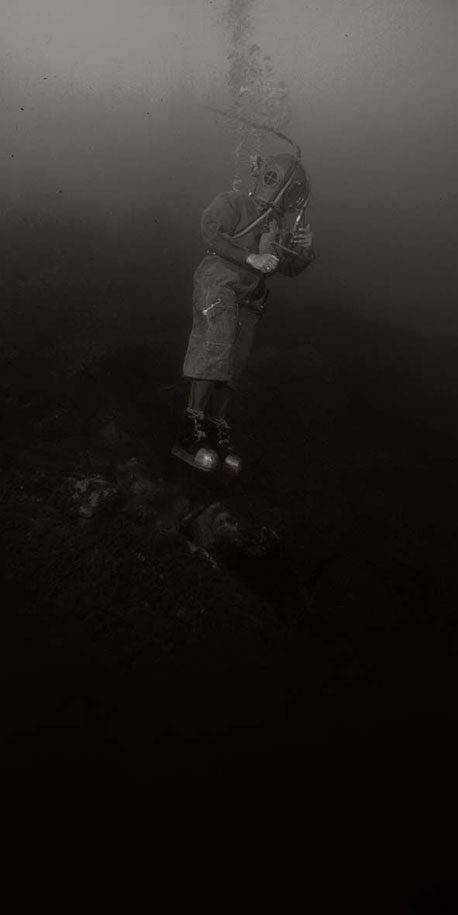
"A mature person sees life as passing by, and instead of being terrified is captivated by the events that are following each another. This exhibition is inspired by J. G. Ballard's Drowned World. But this “drowned world” represents the most profound part of a human being. OUT OF TIME intends to be a pause, not a section of time in movement, or possibly a story, but without a definite narrative. A pause that without filters allows for the perception of some fragments of our humanity that are close to each other and that in spite of being non-essential, may have some importance in the development of a not necessarily common way of thinking."
Ausblick
Martin Newth
25. april 2008 - 31. may 2008
In this exhibition we are presenting new work by Martin Newth, which he developed in January of this year the southern German city of Konstanz. With the help of black cardboard and a simple lens he transformed the small building that houses the water gauge at the entry to the port (and on which the impressive sculpture Imperia by Peter Lenk is rotating) into a camera obscura. Photographic paper that he hung opposite of either window and that he exposed through the small aperture was developed into a negative photograph. We are now showing some of these results, as well as some of the, now positive, prints from these.
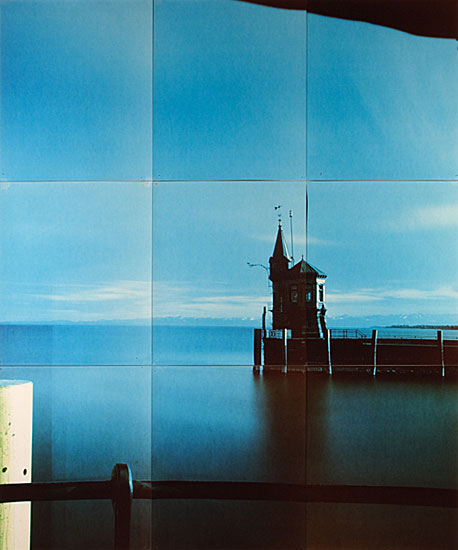
Martin Newth: Bodensee, 20. Januar 2008 (183 x 152,5 cm)
Newth depicts what is there, he presents a contemporary view on a city that has
evolved since the Middle Ages and on the timeless expanse of the lake that has changed
little over time. His photographs, which were created with minimal technical effort, and
which refer back to the time when photography was invented, are at the same time
documents of our present and deserted images of the historical environment. For the first
time with this series, Martin Newth was working with photographic colour paper. The
different colours of natural and studio light are the reason for the chromatic
distortions, which resemble early colour photographs, in which the red and yellow parts
of the image have already faded.
Martin Newth was born in 1973 in Manchester, studied at Newcastle University at the Slade
School of Fine Art in London, and today lives and works in London.
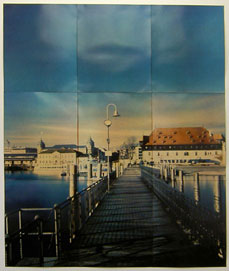
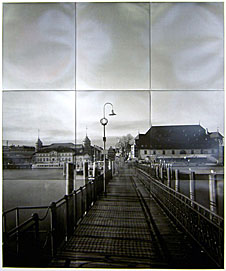
Martin Newth: Konstanz, 19. Januar 2008 (183 x 152,5 cm)
Martin Newth: Konstanz, 19. Januar 2008 (183 x 152,5 cm)
The work in this show developed in the context of the group exhibition 'Menschen und Orte' (www.menschen-und-orte.de) that Axel Lapp has curated for the 150th anniversary of the Kunstverein Konstanz, and that is on show until 29 June 2008. Many of the artists in this exhibition developed work locally and specifically, thereby extending the cultural networks, which shaped the city for centuries and to which the Kunstverein is committed.

Martin Newth: Bodensee, 20. Januar 2008 (183 x 152,5 cm)
Martin Newth: Bodensee, 20. Januar 2008 (183 x 152,5 cm)
a season of film
Sonia Boyce & David Bickerstaff [UK], Nick Crowe & Ian Rawlinson [UK],
Jeanne van Heeswijk & Marten Winters [NL], Mona Jas & Holger Friese [D], Sonia
Khurana [IND], John Sealey [UK].
16. february 2008 – 05. april 2008
Crop Over
Sonia Boyce
09. november 2007 - 26. january 2008
Crop Over is a newly commissioned video and sound work by Sonia Boyce, which premiered at Harewood House in the UK. It's development began with Boyce’s interest in the Crop Over festival in Barbados, a harvest festival that directly originates out of the conditions of plantation life and sugar production in the Caribbean. Crop Over also responds directly to the history of Harewood House and its relationship to the Transatlantic Slave Trade.

Sonia Boyce: Crop Over (Foto: William Cummins)
The film opens with a beautiful stillness and the sound of running water as the camera pans across the formal garden and grounds of Harewood House. Stilt Man wanders through the majestic gardens, confidently negotiating the grounds of this beautiful English country house, his fantastic costume is both admiral-like and carnivalesque. We are then transported to the broody skies that hang over the sugar cane fields in Barbados and to the splendour of a plantation house. The plantation house echoes the grandeur of Harewood but is surrounded by an avenue of exotic palm trees, a pool of water lilies and lotus flowers. Here we are asked to consider the cultivated landscape of both Barbados and Britain, and we are reminded of who owned, worked on and now enjoys these different landscapes. The Crop Over festival comes out of the convergence of these different histories and spaces. As the film unfolds cultural historians comment on the characters of the Crop Over festival, giving us an insight into their history and contemporary meaning.

Sonia Boyce: Crop Over (Foto: William Cummins)
Sonia Boyce was born in London in 1962, where she also lives and works today. She works in diverse media and contexts from the small drawing to monumental performative installations.
BOYS
Nikola Irmer
21. september 2007 - 20. october 2007
In her new series of paintings, Nikola Irmer follows two boys on their excursions through the city. She observes them during their boxing training or after a fight. She notes how they admire the cars through a fence on Brunnenstraße in Berlin or wrestle each other in the park. As in her preceding series about a group of punk girls, a wide variety of portraits emerged from the different situations - the careful study in the studio or the faster sketch after a photo -, alternating in expression somewhere between a childlike tenderness and a streetwise toughness, and thus doing justice to the many-faceted personalities of these adolescents.
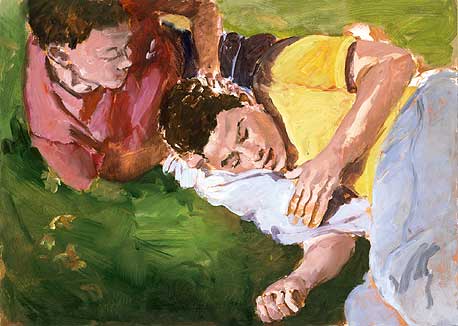
Nikola Irmer was born in Starnberg in 1970. She studied at the San Francisco Art Institute, the Glasgow School of Art and at the Hunter College in New York. Since 2000 she lives and works in Berlin.
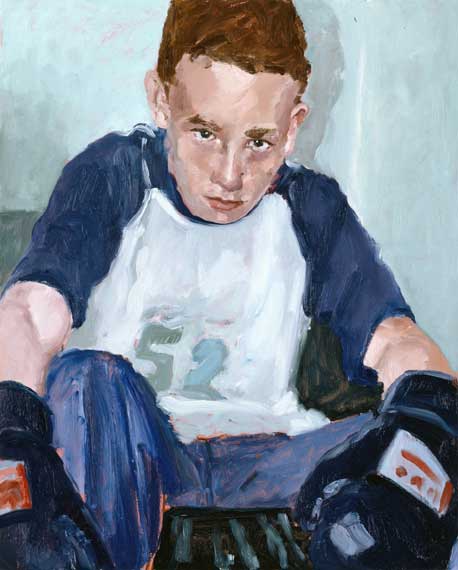
On 29. September 2007 from 10 am to 12 pm we will serve a small brunch in the exhibition, so that you can prepare yourself for the strenuous activities of the various art fairs.
Interlude 2
Katy Devine & Matthew Walters (covert noise research)
30. august 2007, 12.00 - 8.00 pm
For three weeks, Katy Devine and Matthew Walters (covert noise research) took over
Axel Lapp Projects as their studio and base camp in Berlin. From here they explored the
city, its spaces and architectures. They researched its fabric with camera and
microphone, and thus expanded, revised and newly invented their expectations of this
city. Their interests include time, space, orientation and the notion of shifting zones
and boundaries. In their work they concentrate on the composition of the city space, its
patterns and structures, and from that they create visual and aural sequences.
On Thursday, 30. August 2007, covert noise research will present their work from 12.00 to
8:00 pm.
This is the second project in the series 'Interludes', that offers artists and artists' spaces the opportunity to work for some time in Berlin and to establish themselves as part of an international network.
The residency of Katy Devine and Matthew Walters (www.katydevine.co.uk | www.covertnoiseresearch.com) is the result of a collaboration with East Street Arts, Leeds (www.esaweb.org.uk).
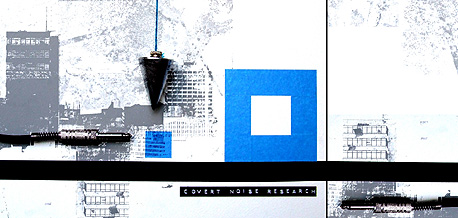
Mayonnaise and Salad Cream
Josephine Flynn
06. july 2007 - 04. august 2007
Josephine Flynn's work is concerned with what she calls the 'lower aesthetics'. She uses and manipulates found images that somehow form a part of our all-embracing consumer culture, and manages to endow them with a new meaning by integrating them into often hilarious narratives, that are autobiographical as well as being critical of the art itself and its medial usage. Working with images of historic and political celebrities, such as George W. Bush and Adolf Hitler, and of banal everyday objects, such as pens, Nurofen tablets and tin foil shaped like human excrement, Flynn's films offer a playful and seemingly naïve (and often rather coarse) take of the images and symbols around us. Yet, the self-referenciality of these films reveals them as a carefully crafted deconstruction of the strategies and hierarchies of our communication. Josephine Flynn's work is outrageous and funny, sometimes embarrassing and always entertaining. Through her anarchic creativity, she fuses the political with unbearable cheesiness, the bold with subtle observations.
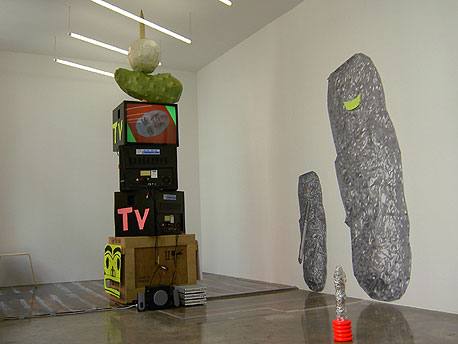
Josephine Flynn: Mayonnaise and Salad Cream, 2007
For this exhibition, her first in Germany, Josephine Flynn is building Totem Kebab, an installation of three monitors on a cocktail stick, complete with a super-sized gherkin on top. Several of her recent films will be on show as part of this installation.
Josephine Flynn was born in Leigh, Greater Manchester, in 1975. She gained an MA Fine Art from Sheffield Hallam University in 2006 and a BA (Hons) Fine Art from Leeds Metropolitan University in 1998. In 2005 Flynn was in the Bloomberg New Contemporaries and she recently showed at Ryan Gander's Associates Gallery in London (www.associatesgallery.co.uk); she has a forthcoming show at International 3 in Manchester (www.international3.com) later this year.
INTERLUDE 1: »Meeting Point«
Apartment (Manchester)
Dave Gledhill, Paul Harfleet, Hilary Jack, Naomi Kashiwagi, Martine Myrup, Lisa Penny,
Maeve Rendle, Cherry Tenneson, Beáta Veszely, David Wilkinson
01. june 2007 - 23. june 2007
Twice a year Axel Lapp Projects is inviting and showcasing the work of art spaces outside of Berlin in a programme entitled 'Interlude'. For the first of this programme, Axel Lapp has selected Apartment, a project and exhibition space, run from a sixth floor one bedroom council flat in central Manchester, co-directed by Hilary Jack and Paul Harfleet.
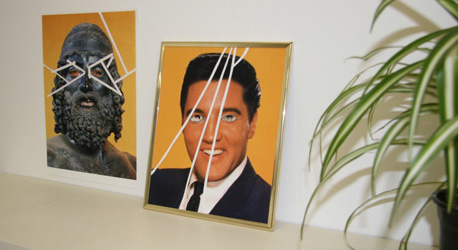
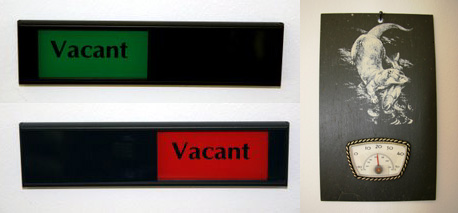
Lisa Penny, Cherry Tenneson, Naomi Kashiwagi
For 'INTERLUDE 1', Hilary Jack and Paul Harfleet have brought together the work of ten artists from Manchester, Budapest, London and Glasgow in a show entitled 'Meeting Point'. The work offers an insight into the breadth of activity that Apartment has facilitated over the last three years and reflects their commitment to this Manchester based exhibition space.
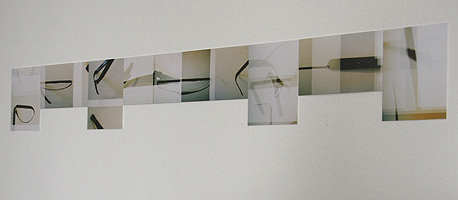


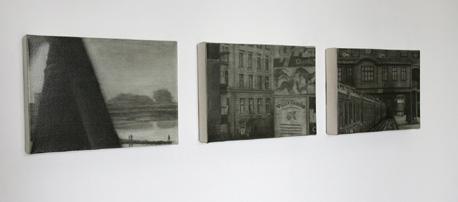 Maeve Rendle, Hilary Jack, David Gledhill
Maeve Rendle, Hilary Jack, David Gledhill
Apartment is based in a flat, and unlike many artist led spaces that operate in this way, the curators choose to present the work alongside the possessions that Paul Harfleet lives amongst. This curatorial decision enables the artwork to position itself in contrast to the objects or to hide within them, camouflaged by the everyday detritus. Each artist presented here, at Axel Lapp Projects, has exhibited at Apartment and has dealt with this reality in a variety of interesting ways.

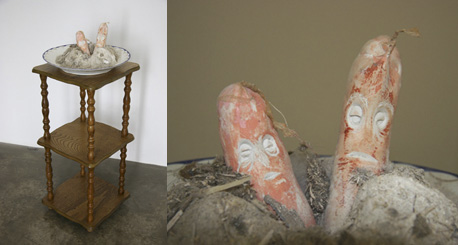
Beata Veszely, David Wilkinson
When artwork is shown at Apartment the interior of the flat frames the work. At Axel Lapp Projects, the flat itself is an absent participant, no longer available as a supporting framework for the presentation of the art work. Therefore the works are able to be re-seen without the context of Apartment, revealing to the curators, the complex relationships that have been formed between the artists and their practices over the three years that Apartment has existed. For the audience the various works are seen within the gallery context and with the knowledge that these relationships were forged in a domestic location; here the artists come together creating a meeting point where the work can be seen in a group show and in a totally new context.
For more information about Apartment and the artists presented here visit: www.apartmentmanchester.blogspot.com
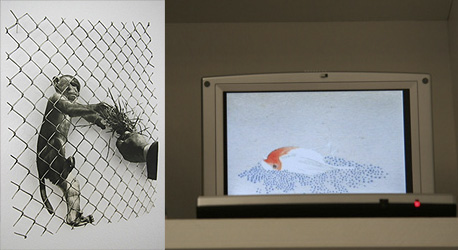

Martine Myrup, Paul Harfleet
The Plejades #1
Mona Jas
20. april 2007 – 19. may 2007
With spezial thanks to Stefan Dörner, Henriette Kolb, Ali Mekaoui and Elisabeth
Helene Simon.
Jutta von Stieglitz-Yousufy (camera, light)
Stephan Maikowski (make-up)
As a starting point for The Plejades #1, Mona Jas used her video piece Ideale that she had created during the last couple of years. There she investigated whether we still depend on ideals in our time, and what those ideals could be. In over 50 filmed conversations, she asked people to talk about their views on ideals. The protagonists were filmed in a very documentary way, head-on and neutrally lit.
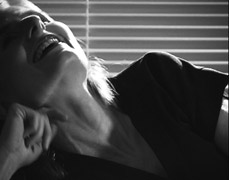
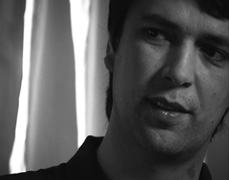
Through her occupation with this material, with what was said and the concepts therein, Jas began to look in more detail at film as a medium and the exaggeration of meaning in the cinematic treatment. From this, she developed the idea to continue working on this project with cinematic means, in a combination of medialised and representative image and documentary interview.


She selected film scenes and moods from films, in which the authors gave a form to their ideals: Gena Rowlands in the films of Cassavetes, Tystnaden (The Silence) by Ingmar Bergman, the films of Pasolini and Tarkowsky. To these Jas assigned four exemplary interviews from Ideale and then filmed the interviewees again in the style of this film, while they saw and heard their initial interview for the first time. Thus, the passivity of watching and hearing is positioned against the heightened expression of cinematic technique, the stylised film against the spontaneous confrontation with the own image and what one said months earlier. With her piece, Mona Jas created a unique commentary on idealisation in our medialised period.

In the exhibition, film and sound are played alternately, so that the duality of image
and sound continues. The complex installation presents some minutes of the films on a
monitor and via a projection, then for a few seconds an extract of the sound can be
heard.
The wall piece Konstellation #2 that is also on show is a documentation of the
preparatory work.
The End of Civilisation
Shezad Dawood
02. march 2007 - 31. march 2007
The show presents the video Tod eines Revolutionärs (Death of a Revolutionary) in which a series of photographs showing the dead Che Guevara is re-enacted. In these, the body of the revolutionary is examined and documented by doctors, photographers and men in uniform - one even puts his fingers in the dead man's wounds, thus repeating the iconic gesture of the doubting Thomas. Dawood re-plays the well-known scenes and adds a new visual version to our knowledge about these historic events. He supplements the static images of our memory with a filmic version - that might not be accurate in all detail, yet that provides much of the historic information. He examines how we deal with history, how media is affecting this relationship, and how we are influenced by the power of historic images.
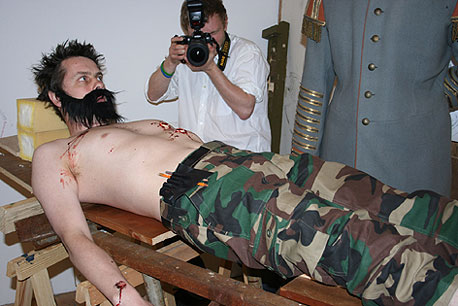 Tod Eines Revolutionärs; Performance Still 2006
Tod Eines Revolutionärs; Performance Still 2006
The film was made in Berlin, and like in most of Dawood's films and performances the actors are from the world of art. Thus, Ché is played by the German artist John Bock.
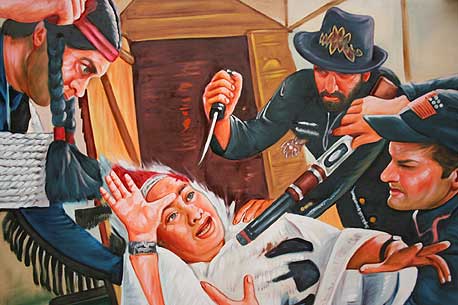
Op2. Real Estate, Oil on canvas 180 x 120 cm
Several history paintings complement the exhibition. They were recently painted for Dawood in Pakistan, and show encounters between revolutionaries and American Indians, between historic soldiers and aliens (which turn out to be Inca priestesses from a performance in Venice). The various narratives combine in these paintings to very unprobable stories and question the value system of historic story telling.
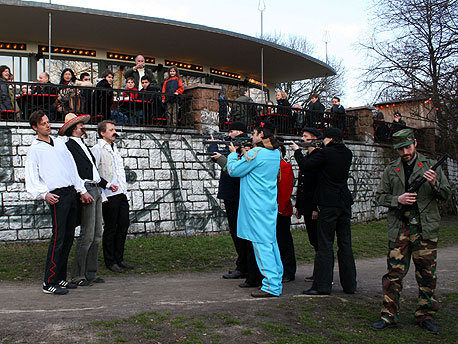 The
Death of Maximilian; Performance Still 2007
The
Death of Maximilian; Performance Still 2007
On the afternoon of the 04. March, Shezad Dawood will stage the Performance The Death of Maximilian in the Volkspark am Weinberg at the corner of Brunnenstraße and Veteranenstraße (meeting at the gallery at just before 3 pm).
Shezad Dawood lives and works in London. He studied at Central St. Martin’s
College for Art & Design and at the Royal College of Art. His last solo show was in
2006 Artists’ Studio in London. For this year shows at Thomas Erben in New York,
AKA in Rome, Paradise Row in London and Wysing Arts in Cambridge are planned.
Thomas Erben, NY (July 2007), AKA Rome (November 2007) & Paradise Row, (November
2007) and FEATURE a l arge-s cale film/performa nce event at Wy sing
(August/September 2007), touring to Cast lefield Gallery , Manchester (June
2008).
REVIEW
Sonia Boyce, Jeanne van Heeswijk, Nikola Irmer,
Holger Friese, Nick Crowe
26. january 2007 – 24. february 2007
The view on a work of art while viewing it is most of the time not only directed at
this work alone. It takes into account previous works and compares each work to an
œuvre. It reveals connections and clarifies a possible intention, which at the same
time it also establishes. The task of authors, critics and curators lies in making these
connections visible for their audience, whereby the continuity of an œuvre –
the recognisability of the work –increases also their mercantile
possibilities.
The works in this exhibition by Sonia Boyce (London), Nick Crowe (Manchester/Berlin),
Nikola Irmer (Berlin), Jeanne van Heeswijk (Rotterdam/New York) and Holger Friese
(Berlin) present this review of previous work from the perspective of the artist. In very
different ways, they all reconsider earlier works kontextualise these again. They thus
document the constant interaction of reception and introspection as a central part of the
artistic prospect.
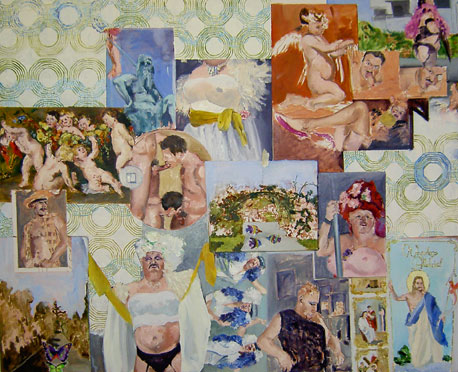 Nikola Irmer: o.T. (Tapete)
Nikola Irmer: o.T. (Tapete)
The starting point for this exhibition was Nikola Irmer’s painting o.T. (Tapete)(Untitled (Wallpaper)), 2006, in which she looks at the reception of her pictures and the continued use of their illustrations. It is based on pictures from a bar, where images from one of her catalogues are used for decoration, and on photographs of notice boards. Next to pictures of her model Horst, there are religious illustrations and images of Neptun and of various Putti on this depiction of a piece of wall, and also some decidedly pornographic material – very profane and nevertheless in the art-historical tradition of so many pictures of collections.

Nick Crowe: Pompei
Nick Crowe’s digital slide show Pompei, 2007, is also concerned with the afterlife of his works. He describes a tour of his virtual alter ego through some of his earlier net-based works. For these he had created Avatars, which in the diversity of today’s internet are almost unnoticeable.
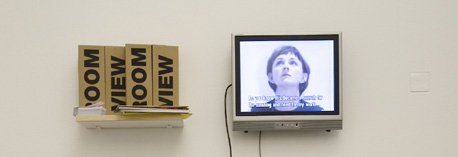
Jeanne van Heeswijk: Room with a View (Real Stories from Life)
In Room with A View (Real Stories from Life), 1997, by Jeanne van Heeswijk, the actress Joke Tjalsma describes in a multilayered monologue the history of the project Room with A View, its changing manifestations and their different perspectives of perception. It re-enacts and documents the preceding exhibitions and thus becomes an independent part of the project.

Holger Friese: Buchhalter
Holger Friese’s Buchhalter (Book Holder), 2007, unites elements referring to the Internet piece www.antworten.de, 1997, by Holger Friese & Max Kossatz. Two photographs are attached to the wooden frame, detailing the interior of the New York delicatessen store Russ & Daughters, in which the original Internet piece was conceived. From behind these photographs one can just about hear the original sound loop of the website. The book that was published by The Green Box documents and describes this piece, and each step of its programme and thus offers the opportunity of an accurate approximation.
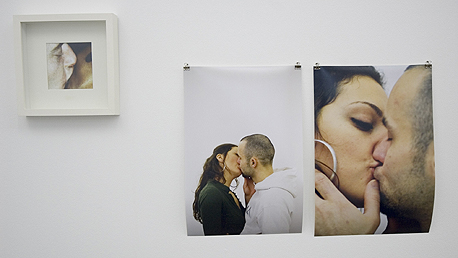
Sonya Boyce: Again (Michelle + Stefan, Berlin)
Sonia Boyce recreated the piece Mm (Barney + Cora, London), 1995, for this exhibition. The historic kiss was re-enacted in the exhibition space with two young Berliners, and Again (Michelle + Stefan, Berlin), 2007, again poses questions about intimity and proximity, exhibitionism and observation in the art.
